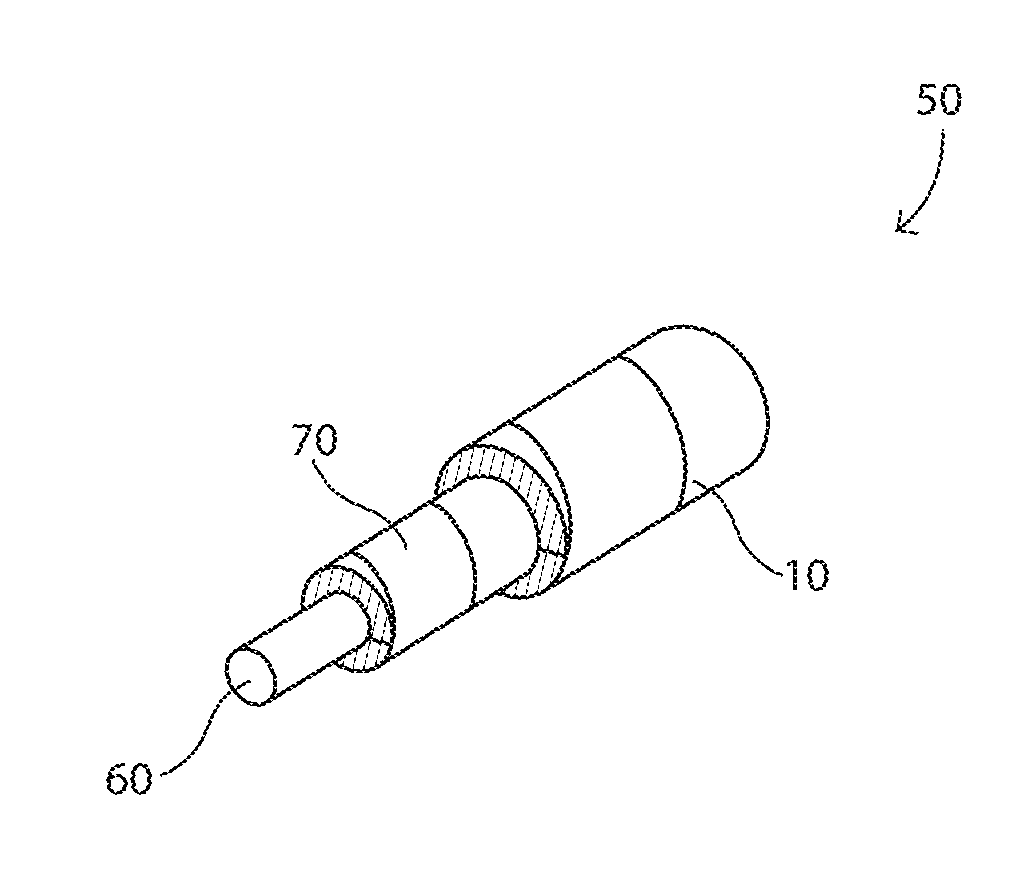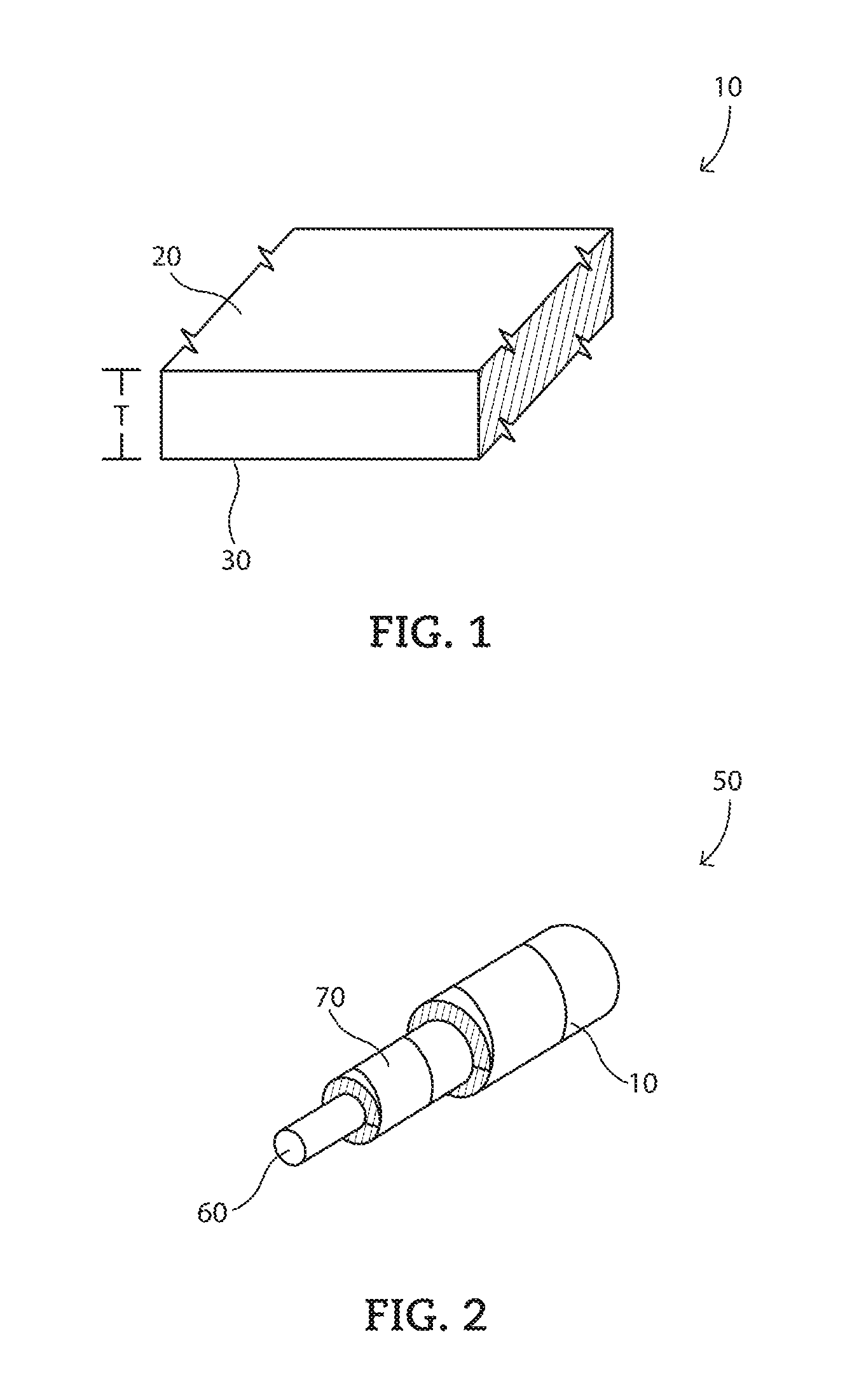Laser-markable insulation material for wire or cable assemblies
a technology of insulation material and insulation material, which is applied in the direction of greenhouse cultivation, record information storage, synthetic resin layered products, etc., can solve the problems of pyrolization and arc tracking, difficult to achieve initial contrast ratios greater than 60% and heat-aged contrast ratios greater than 40% using titanium dioxide pigments, and high titanium dioxide levels that are negatively correlated with electric arc tracking and propagation resistan
- Summary
- Abstract
- Description
- Claims
- Application Information
AI Technical Summary
Benefits of technology
Problems solved by technology
Method used
Image
Examples
examples 1a and 1b
[0105]TiO2 pigment and 18-22 pph (of resin weight) Isopar were weighed into a plastic container, which was subsequently placed in an ice bath. The suspension was blended using a Ross high-shear mixer for a period of 10 minutes. The suspension was carefully added to 1 pound of homopolymer PTFE resin in wide-mouthed 0.5 gallon jar that was cooled below 19 degrees Celsius. The mix was passed through a sieve (ASTM E-11 No. 8 with 0.0937 inch opening) to eliminate large clumps and mixed on a jar mill for 20 minutes below 19 degrees Celsius. After incubating at room temperature for 12 hours, the mix was cooled below 19 degrees Celsius and mixed for 5 minutes on a jar mill. After warming to room temperature, the mix was paste extruded to produce 0.1 inch cylindrical beads using a lab-scale paste extruder. The beads were suspended from a rack, and a 33 gram weight was tied to the bottom of each bead to prevent the bead from curling. The beads were sintered at 360 degrees Celsius for 5 minut...
examples 2-11
[0109]Mixes containing 30 pounds of non-melt-processable perfluoropolymer resin, TiO2 pigment, and 18-22 pph Isopar were prepared in an analogous manner to that in which mixes were prepared on the lab scale in Example 1, except that the TiO2 / Isopar suspension was sprayed onto resin tumbling within a rotating panning mixer. After incubating for 12 hours at room temperature, the mix was pressed into preforms to eliminate air voids, and the preforms were extruded in a ram extruder through a flat die. The sheet-like extrudate was calendered to produce a thin film, which was transferred over heated steam cans to evaporate the lubricant. The resulting 50 micron film was slit into narrow strips of tape for testing. The polymer type, TiO2 grade, and TiO2 loading used in Examples 2-8 are listed in Table 2 below.
[0110]Contrast ratios were also measured and are reported in Table 1. Contrast-ratio measurements were conducted according to either or both Contrast Ratio Sample Test Constructions 2...
examples 12-13
[0111]The same process as that used in Examples 2-11 was used in Examples 12-13, except that the resin batch size was 75 pounds. Further, the thickness of the insulation material was 3 mils.
TABLE 2Ex. 2Ex. 3Ex. 4Ex. 5Ex. 6Ex. 7Ex. 8Ex. 9Ex. 10Ex. 11Ex. 12Ex. 13Insulation-2.02.02.02.02.02.02.02.02.02.03.03.0materialThickness(mils)Homopolymer40%40%40%100% —40%40%100% 40%40%100% 40%PTFE (wt. % ofpolymermatrix)Fluorinated60%60%60%—100% 60%60%—60%60%—60%Copolymer(wt. % ofpolymermatrix)Laser PolymerAltirisAltirisAltirisAltirisAltirisAltirisAltirisAltirisAltirisAltirisAltirisAltirisPigment550800550550500550550550550550550550andandR105R105Pigment3.22.02.02.01.81.81.31.81.75 of1.5 of2.02.0Loading (pph)AltirisAltiris550550andand0.05 of0.5 ofR105R105Initial CR63%—64%64%63%59%57%—69%58%——under CRTest 2Aged CR54%—55%53%54%50%47%—54%44%——under CRTest 2Initial CR——70%—————67%———under CRTest 3Heat-aged CR——63%—————60%———under CRTest 3Initial CR——68%——64%62%—————under CRTest 4Heat-aged CR——61%——55%5...
PUM
| Property | Measurement | Unit |
|---|---|---|
| Temperature | aaaaa | aaaaa |
| Temperature | aaaaa | aaaaa |
| Length | aaaaa | aaaaa |
Abstract
Description
Claims
Application Information
 Login to View More
Login to View More - R&D
- Intellectual Property
- Life Sciences
- Materials
- Tech Scout
- Unparalleled Data Quality
- Higher Quality Content
- 60% Fewer Hallucinations
Browse by: Latest US Patents, China's latest patents, Technical Efficacy Thesaurus, Application Domain, Technology Topic, Popular Technical Reports.
© 2025 PatSnap. All rights reserved.Legal|Privacy policy|Modern Slavery Act Transparency Statement|Sitemap|About US| Contact US: help@patsnap.com


